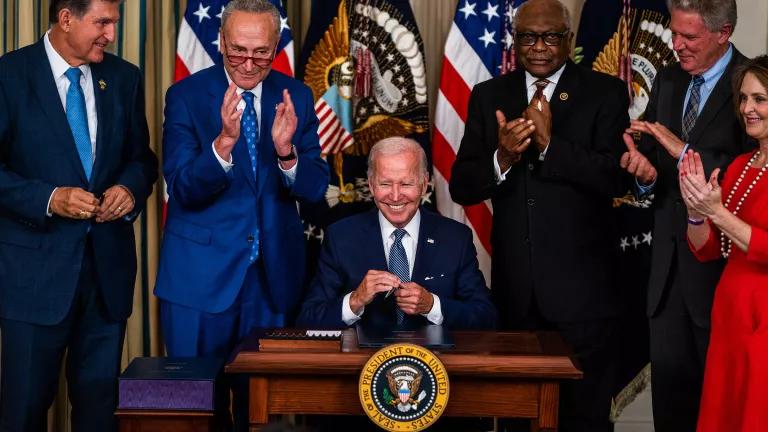Infrastructure Law Is a Chance to Build with Clean Materials
Secretary Buttigieg must not overlook the opportunity to pair billions in infrastructure investments with programs to purchase low carbon construction materials—building railways, roads, and bridges with cleaner concrete, cement, and steel.

The Infrastructure Investment and Jobs Act (IIJA) includes historic levels of spending on surface transportation, which accounts for roughly half the total package of $1.2 trillion -- the largest-ever five-year surface transportation reauthorization. Whether the new law’s transportation investments exacerbate our climate crisis or help us achieve our climate goals – and more equitable and sustainable mobility options for communities across the country – will depend on how the U.S. Department of Transportation (U.S. DOT) and state and regional agencies implement its key provisions.
Foremost, NRDC believes agencies must take advantage of the flexibility afforded them by Congress to channel funding towards cleaner alternatives to new roadbuilding, including buses, trains, and electric vehicles. But Secretary Buttigieg must not overlook the opportunity to pair billions in infrastructure investments with programs to purchase low carbon construction materials. Doing so will ensure that whether we are building railways, roads or bridges, we are literally Building Back Better with cleaner concrete, cement, and steel.
The industrial sector, which includes the production of concrete, steel and other widely used building materials, was responsible for 23% of U.S. greenhouse gas (GHG) emissions in 2019. Because the federal government – and, in particular, U.S. DOT – is a top buyer of these materials for federally funded transportation infrastructure, public procurement is a key lever in growing early markets for low carbon alternatives and driving transformative changes in industrial plants and processes. And because of how ubiquitously these materials are used in our built environment, if U.S. DOT flexed its purchasing power to encourage even modest reductions in embodied emissions, it could add up to major climate impacts.
Moreover, the impact would not be limited to reducing the GHG footprint of the materials purchased directly by the government – though as a top purchaser of materials like concrete and steel, that direct impact could be substantial. As more companies adopt cleaner manufacturing processes and/or products to compete for the large pool of federally funded construction business, those same manufacturers will be selling low carbon materials to buyers in the broader private market, alongside the public sector. This “indirect impact” has the potential to significantly increase emissions savings and lower costs compared to public infrastructure projects alone.
In addition to funding significant investment in transit and intercity rail, alongside traditional highway funding, the IIJA includes many new and highly competitive grant programs, which add up to more than $100 billion in funding. U.S. DOT should exert as much of its authority as possible to ensure that grantees competing for this funding account for the climate and equity impacts of their projects. Low carbon materials procurement incentives should be part of this process.
Procurement by state and local grantees applying for these new funding streams must build in consideration of the carbon intensity of construction materials used for a project. This should include:
- measurement of the embodied emissions of materials like concrete, using a well-known reporting document called an Environmental Product Declaration (EPD). EPDs are the best practice for measuring the GHG emissions generated during the production of industrial building materials and products, and the federal government is key to encouraging and standardizing their use. As we discussed here, the Biden administration is already taking important steps in this direction; and
- a mechanism for crediting the use of low carbon options and thereby integrating climate performance into their awarding of contracts, alongside cost.
There are multiple approaches that could be taken to encourage lower embodied emissions in widely used construction materials. Options for project competition criteria under new and existing programs include, but are not limited to:
- establishing a maximum carbon intensity ceiling for commonly used construction materials in public projects;
- offering a percentage discount to bids with the lowest carbon intensity, as captured in an EPD, effectively making them more cost competitive;
- awarding performance-based bonuses to suppliers that deliver lower embodied carbon materials, as a new low carbon concrete procurement bill introduced in NY would do;
- offering price premiums as an incentive to contractors and/or suppliers to change their behavior, on top of whatever price premium applies to the materials themselves. [We estimate that with improved information on the embodied emissions of cement and steel, for example, GHG savings of 10-20% are available at very low premiums, and deeper decarbonization (60%+) could be available at a higher but still modest premium of ~10-15%]; and/or
- creating a ‘super performer’ tier and set-aside pool of funding to encourage bids that significantly outperform their competitors or meet an exceptional level of GHG emissions reduction.
As US DOT ramps up implementation of the largest transportation law in history, the Administration must seize this opportunity to continue its momentum on low carbon materials procurement. One of the most significant and immediate opportunities is to advance procurement pilots at U.S. DOT as part of implementing the generational transportation infrastructure investment funded by the IIJA.
The Bipartisan Infrastructure Law provides an unprecedented opportunity to transform the materials supply chain for transportation. We urge Secretary Buttigieg to use the new authorities and tools in the law to maximum effect, including embedding cleaner materials into the roads and rails Americans travel on every day.


